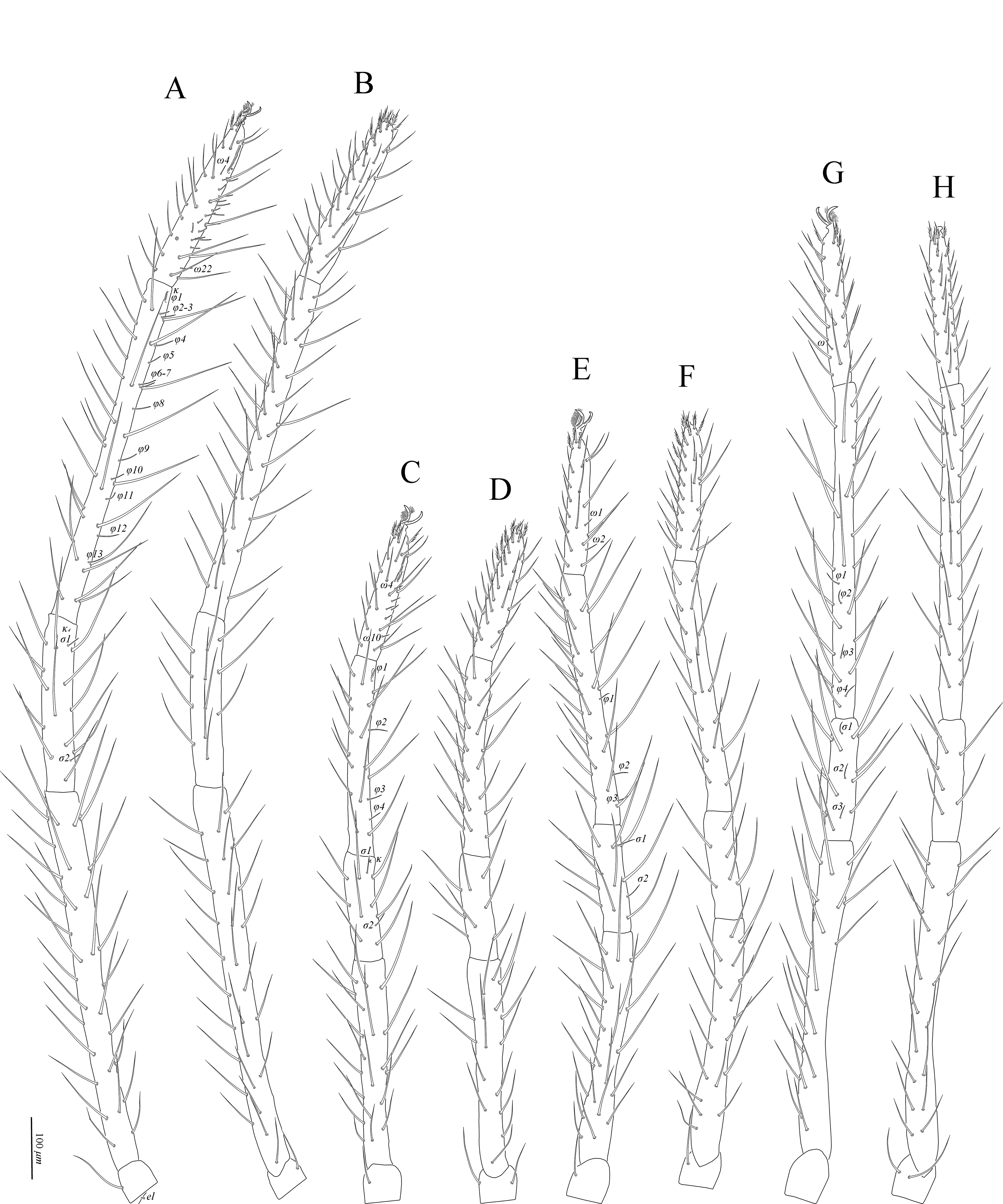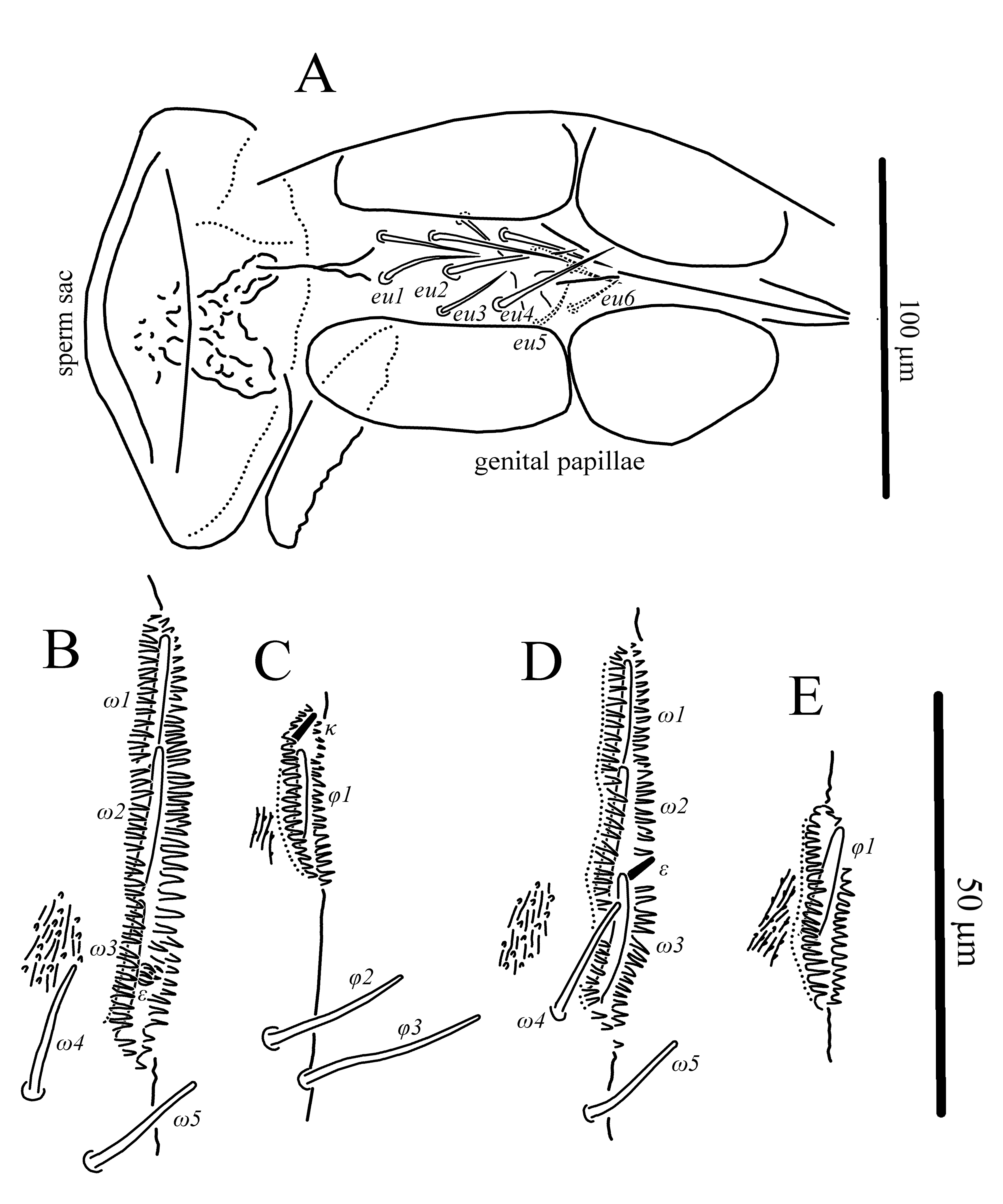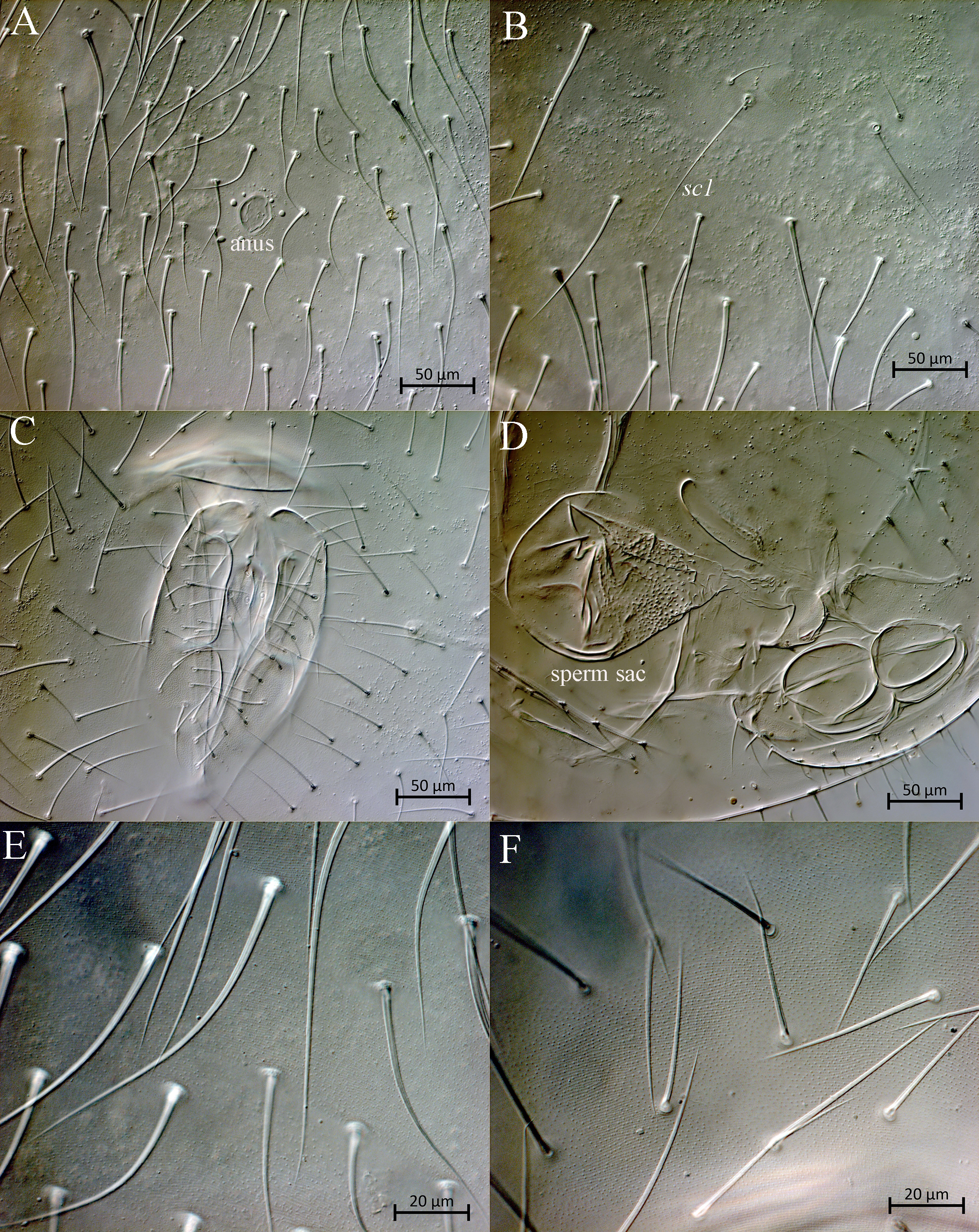A new species of Linopenthaleus Willmann (Acari: Eupodoidea: Penthaleidae) from Far East of Russia
Khaustov, Alexander A.  1
and Kravchenko, Sergey V.
1
and Kravchenko, Sergey V.  2
2
1✉ X-BIO Institute, University of Tyumen, Tyumen, 6 Volodarskogo Str., 625003, Russia.
2X-BIO Institute, University of Tyumen, Tyumen, 6 Volodarskogo Str., 625003, Russia.
2025 - Volume: 65 Issue: 4 pages: 1044-1053
https://doi.org/10.24349/4wh1-pmzyZooBank LSID: E24679D6-8DCA-4F05-BB13-C763463CF8FA
Original research
Keywords
Abstract
Introduction
The family Penthaleidae comprises five genera: Penthaleus Dugès, 1834, Chromotydaeus Berlese, 1903, Linopenthaleus Willmann, 1951, Linopenthaloides Strandtmann, 1981, and Turanopenthalodes Barilo, 1988 (Khaustov 2016; Beron 2022). The genus Halotydeus Berlese & Leonardi, 1902, which was previously placed in the family Penthaleidae, was transferred to Penthalodidae (Khaustov 2015). Penthaleid mites are obligate phytophages and include the economically important pest Penthaleus major (Dugès, 1837) known as the winter grain mite or blue oat mite (Walter et al. 2009).
The monotypic genus Linopenthaleus, with the type species L. irki Willmann, 1951, was described from Austria (Willmann 1951). Willmann (1951) evidently regarded the taxon reported by Irk (1939) as Linopodes? sp. to be conspecific with L. irki . Later Schweizer and Bader (1963) redescribed this species based on new material from Switzerland. Both Willmann's original description and the Schweizer and Bader redescription are incomplete and probably inadequate. Since that time, no additional redescriptions of L. irki have been provided.
During this study of phytophagous mites in Asian Russia, we collected several specimens of a new species of Linopenthaleus from the Russian Far East.
Material and methods
Mites were extracted from the samples of mosses using Berlese funnels and mounted in Hoyer's medium. Mites were studied using a Carl Zeiss AxioImager A2 compound microscope with phase contrast and DIC objectives. Notations for the prodorsal and leg setae follow that of Lindquist and Zacharda (1987) and Baker (1995), and the remaining nomenclature is as applied to eupodoids by Baker (1990). All measurements are given in micrometres (μm) for the holotype. In description of leg setation the number of solenidia is given in parentheses. Photographs were taken with an AxioCam ICc5 digital camera.
Systematics
Family Penthaleidae Oudemans, 1931
Genus Linopenthaleus Willmann, 1951
Type species: Linopenthaleus irki Willmann, 1951, by original designation.
Revised diagnosis



Adults — Idiosoma oval (Fig. 1). Cuticle soft and striate-tuberculate (Figs 7E, F). Sejugal furrow not developed. Idiosomal chaetotaxy distinctly polytrichous. Naso (epivertex) small, with or without setae, situated on anterior margin of prodorsum. Lens-like eyes present or not discernible. Trichobothria (sc1) smooth (Fig. 7B). Other idiosomal setae simple, smooth; one pair of setae anterolaterad trichobothria distinctly shorter than others (Figs 7A, B). Lyrifissures ia, im and ip very small and hardly discernible (Fig. 2), ih not discerned. Anal opening small, situated dorsally (Fig. 7A) and forming chitinised tube. Six pairs of smooth eugenital setae (Fig. 6A). Two pairs of very large genital papillae.
Gnathosoma – (Fig. 4). Palp setal formula 0-5-3-9(ɷ), solenidion erect. Palps short, tarsus short and truncated. Chelicerae: seta cha present; movable digit thickened basally and thin in distal half; fixed digit with three subequal terminal processes and one dorsal process. Subcapitulum with two pairs of short adoral setae (or1, or2), two pairs of smooth subcapitular setae (sbc1, sbc2) and with additional setae in basal part of subcapitulum.
Legs – (Fig. 5). All legs very long, longer than body. Coxal fields II and III clearly separated from each other. Femora I–IV not divided, femur IV not enlarged. Tarsi I and II with longitudinally aligned rhagidial solenidia in depressions. Famulus (ε) on tarsus I stellate; famulus on tarsus II baculiform. Tibia I with one rhagidial solenidion and famulus k in shallow depression; tibia II with one rhagidial solenidion in shallow depression. Genua I and II with one dorsodistal peg-like famulus k. Genu, tibia and tarsus of all legs with erect solenidia. Most setae on leg segments long and smooth, some anterolateral and anteroventral setae on tarsi I-IV strongly barbed. All tarsi with a pair of serrated claws and narrow baculiform empodium with long hair-like projections.
Male with sperm sac (Fig. 7D).
Immatures — Unknown.
Species included
The genus Linopenthaleus includes two species: L. irki Willmann from Europe (Austria and Switzerland) and L. orientalis n. sp. from Far East of Russia. Linopenthaleus species most likely are bryophagous, feeding primarily on mosses.
Linopenthaleus orientalis n. sp.
ZOOBANK: 12776D6D-310B-4531-843B-BF2F4E3812A9 ![]()
(Figs 1–7)
Description
Male — (Holotype). Live mites with black body, red legs, anus and mouthparts. Length of idiosoma 1005, greatest width 845.



Idiosomal dorsum – (Figs 1, 2, 7A, B, E). Integument finely striated, with small round tubercles (Fig. 7E). Naso without setae. Tactile dorsal idiosomal setae present in large numbers, smooth, variable in length; anterolateral parts of prodorsum without setae (Fig. 2). Eyes not discerned.



Idiosomal venter – (Figs 3, 6A, 7C, D, F). Integument similar to that of the dorsal surface (Fig. 7F). Coxal fields faintly defined. Large areas posterolaterally to legs IV without setae. Genital valves with numerous smooth genital setae (Fig. 7C). Anterior pair of genital papillae larger than posterior one (Fig. 6A). Sperm sac rugose in basal half and smooth distally (Fig. 7D).



Gnathosoma – (Fig. 4). Palp (Figs 4B-D) short, with striate-granulate integument; all setae of femorogenu and seta d of tibia smooth and pointed; setae (l) strongly barbed. Palptarsus very short and wide; setae (p) and acm distinctly blunt-tipped, eupathid-like, other setae pointed; setae d, acm, (p), and v with small numerous barbs in basal part, other tarsal setae pointed; seta v bifurcated distally. Chelicera (Fig. 4A). Integument of shaft smooth on paraxial face, spiculate over remainder, seta cha smooth, pointed. Subcapitulum with short, smooth adoral setae or1 and or2, located subterminally on membranous malae; subcapitular setae sbcl about 1.5 times longer than sbc2. Area posteriad setae sbc1 with 11 simple setae (Fig. 4E).






Legs – (Figs 5, 6B-E). Integument on leg segments similar to that of idiosomal dorsum. Lengths of legs (without claws): leg I-1810, leg II-1100, leg III-1250, leg IV-1565. Leg I (Figs 5A, B, 6B, C): supracoxal seta el smooth, baculiform, setal formula: Tr 2, Fe 58, Ge 24(2σ, 1k), Ti 66(13φ, 1k), Ta 66(22ω, 1ε). Rhagidial organ on tarsus I with three rhagidial solenidia arranged longitudinally in single depression (Fig. 6B); famulus ε (stellate seta) located laterad basal solenidion of rhagidial organ I; 19 erect solenidia located dorsally posteriad rhagidial organ I. Tibia with 12 dorsal erect solenidia located posteriad rhagidial solenidion φ1; genu with two dorsal erect solenidia. Six pairs of anterolateral and distiventral tarsal setae strongly barbed, other leg setae smooth. Leg II (Figs 5C, D, 6D, E): setal formula: Tr 3, Fe 36, Ge 17(2σ, 1k), Ti 39(4φ), Ta 52(10ω, 1ε). Rhagidial organ on tarsus II with three rhagidial solenidia arranged longitudinally in single depression (Fig. 6D); famulus ε baculiform, located laterad insertion of second rhagidial solenidion in rhagidial organ II; nine erect solenidia arranged serially posteriad rhagidial organ II. Tibia with three dorsal erect solenidia; genu with two dorsal erect solenidia. Seven pairs of anterolateral and anteroventral tarsal setae strongly barbed, other leg setae smooth. Leg III (Figs 5E, F): setal formula: Tr 2, Fe 42, Ge 17(2σ), Ti 45(3φ), Ta 50(2ω). Tarsus with two dorsal erect solenidia; tibia with three dorsal erect solenidia; genu with two dorsal erect solenidia. Tarsus with 11 anterolateral and anteroventral setae strongly barbed, other leg setae smooth. Leg IV (Figs 5G, H): setal formula: Tr 2, Fe 38, Ge 18(3σ), Ti 53(4φ), Ta 49(1ω). Tarsus with one dorsal erect solenidion; tibia with four dorsal erect solenidia; genu with three dorsal erect solenidia. Tarsus with 10 anterolateral and distiventral setae strongly barbed, other leg setae smooth.



Female — Differs from male only by lack of sperm sac. One damaged specimen does not allow for accurate measurements.
Type material
Male holotype, slide SK0624, Russian Federation, Primorskiy Krai, Kedrovaya Pad' State Biosphere Nature Reserve (43.106312N 131.52438°E), in moss, June 2024, coll. S.V. Kravchenko; paratypes: one female and one male, same data.
Type deposition
All specimens are deposited in the acarological collection of the University of Tyumen (Russia).
Etymology
The name of the new species refers to geographical distribution in oriental part of Russia.
Differential diagnosis
The new species differs from L. irki in lacking setae on the naso and having much more numerous (\textgreater100) dorsal idiosomal setae of different lengths (vs. naso with a pair of setae and dorsal idiosoma with less than 30 long setae of approximately same length in L. irki); male sperm sac smooth distally (vs. male sperm sac rugose distally in L. irki).
Discussion
The primary diagnostic feature of Linopenthaleus is its exceptionally long legs, which exceed the body length (Willmann 1951; Strandtmann 1981). Similarly long legs are also present in Linopenthaloides, but it is characterized by divided femora and contiguous coxal fields II and III as well as the ventroterminal anal opening. In Chromotydeus, the legs are also very long, but it clearly differs from Linopenthaleus in having the palptarsus long and slender and tarsus III with a rhagidial organ. The discovery of L. orientalis n. sp. revealed additional diagnostic characters for the genus. Linopenthaleus differs from the closely related genus Penthaleus in having the basal part of the subcapitulum with additional setae; in Penthaleus, this part is without setae. Additional setae on the basal part of the subcapitulum in Penthaleidae are also known in the genus Turanopenthalodes (Khaustov 2016), but its legs are all shorter than the body. Another potential diagnostic character for Linopenthaleus is the presence of an erect solenidion on tarsus IV, which is absent in Penthaleus, Turanopenthalodes and Linopenthaloides. Unfortunately, all of these character states, as well as many other important diagnostic characters, were not described for the type species, L. irki. Willmann (1951), in the original description of L. irki, mentioned and illustrated the presence of a pair of eyes. Most likely, this pair is represented by eye spots that are only well-visible in live mites . A similar condition is well-known in Penthaleus, where eyes are visible in live mites but external lens-like structures are not discernible on mounted specimens. A redescription of the type species, L. irki, based on Willmann's available type material, is necessary to clarify the diagnostic characters of the genus Linopenthaleus.
Acknowledgements
Sample collection was carried out in the territory of the Federal State Budgetary Institution Joint Directorate of Kedrovaya Pad' State Biosphere Nature Reserve and Land of the Leopard National Park. The present research was supported by the Russian Science Foundation, grant No. 25-14-00118.
References
- Baker A.S. 1990. A survey of external morphology of mites of the superfamily Eupodoidea Banks, 1894 (Acari: Acariformes). J. Nat. Hist., 24: 1227-1261. https://doi.org/10.1080/00222939000770741
- Baker A.S. 1995. A redescription of Halotydeus destructor (Tucker) (Prostigmata: Penthaleidae) with a survey of ontogenetic setal development in the superfamily Eupodoidea. Int. J. Acarol., 21: 261-282.
- Beron P. 2022. Acarorum catalogus X: Trombidiformes Prostigmata. Superfamilia Labidostommatoidea (Labidostommatidae). Superfamilia Eupodoidea (Eupodidae, Dendrochaetidae, Rhagidiidae, Eriorhynchidae, Pentapalpidae, Penthalodidae, Penthaleidae, Proterorhagiidae, Strandtmanniidae). Superfamilia Tydeoidea. Ereynetidae. Superfamily Paratydeoidea. Paratydeidae. Superfamilia Anystoidea (Anystidae, Erythracaridae, Teneriffiidae, Pseudocheylidae, Stigmocheylidae). Superfamilia Caeculoidea (Caeculidae). Superfamilia Adamystoidea (Adamystidae). Superfamilia Pomerantzioidea (Pomerantziidae). Pensoft & National Museum of Natural History & Bulgarian Academy of Sciences, Sofia-Moscow, pp. 411-420. https://doi.org/10.3897/ab.e68612
- Irk, V. 1939. Die terricolen Acari der Ötztaler und Stubaier Hochalpen. Ver. Mus. Ferd., 19: 145-190.
- Khaustov A.A. 2015. A new species of the genus Protopenthalodes (Acari: Penthalodidae) from Crimea. Acarina, 23: 139-151.
- Khaustov A. 2016. Redefinition of the genus Turanopenthalodes (Acari: Eupodoidea: Penthaleidae), with a redescription of Turanopenthalodes polytrichus. Syst. Appl. Acarol., 21(5): 672-680. https://doi.org/10.11158/saa.21.5.8
- Lindquist E.E, Zacharda M. 1987. A new genus and species of Rhagidiidae (Acari: Prostigmata) from Chihuahuan Desert litter in New Mexico. Can. J. Zool., 65: 2149-2158. https://doi.org/10.1139/z87-328
- Schweizer J., Bader C. 1963. Die Landmilben der Schweiz (Mittelland, Jura und Alpen) -Trombidiformes Reuter. Denkschr. schweiz. naturf. Ges., 84: 209-378.
- Strandtmann R.W. 1981. A new genus and species of penthaleid mite (Acarina: Penthaleidae) from New Zealand. Pacif. Ins., 23: 392-395.
- Walter D.E., Lindquist E.E., Smith I.M., Cook D.R., Krantz G.W. 2009. Order Trombidiformes In: Krantz G.W., Walter D.E. (Eds.) A Manual of Acarology. Third Edition. Texas: Texas Tech University Press, Lubbock. p. 223-420.
- Willmann C. 1951. Die hochalpine Milbenfauna der mittlern Hohen Tauern ins besondere des Grossglocknur-Gebietes (Acari). Bon. Zool. Beitr., 2: 141-176.



2025-06-17
Date accepted:
2025-10-10
Date published:
2025-10-15
Edited by:
Chetverikov, Philipp

This work is licensed under a Creative Commons Attribution 4.0 International License
2025 Khaustov, Alexander A. and Kravchenko, Sergey V.
Download the citation
RIS with abstract
(Zotero, Endnote, Reference Manager, ProCite, RefWorks, Mendeley)
RIS without abstract
BIB
(Zotero, BibTeX)
TXT
(PubMed, Txt)



